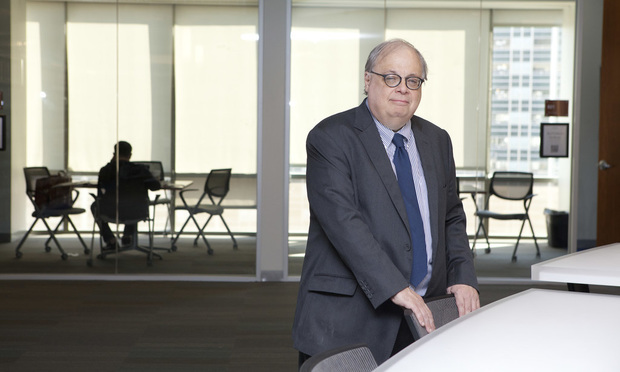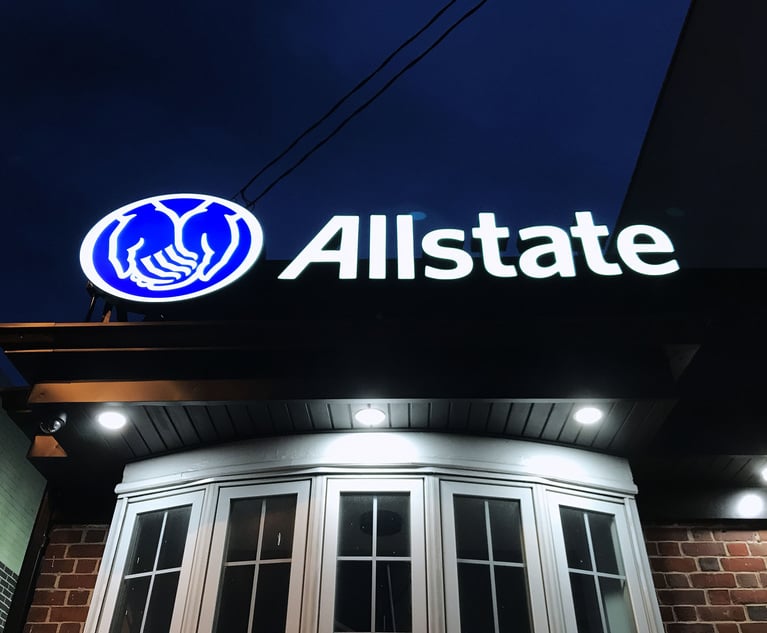The First Amendment, COVID-19 and the Freedom to Practice Religion
The rough and tumble of First Amendment litigation. That's what the Founders wanted, with their unshakable belief that the best antidote to bad ideas are better ones. A good reminder of what we stand for in hard times.
June 11, 2020 at 08:58 PM
6 minute read
 Michael P. Maslanka, assistant professor of law, UNT Dallas College of Law.
Michael P. Maslanka, assistant professor of law, UNT Dallas College of Law.
The First Amendment course is in my law school teaching portfolio. So, I read with great interest last Friday's late-night Supreme Court order denying, by a 5-4 vote, injunctive relief to a Southern Californian church to enjoin the state government's order relating to holding its church services in the age of COVID-19.
Before diving into the deep end of the pool, let's look at some history. Before the ratification of the First Amendment the states had differing views on protection of religion. In one corner were the states protecting religious worship (the narrow view) and in the other corner were the states protecting religious expression (the expansive view). The second won out and that's why our First Amendment protects expression. All sorts of expression ended up being protected: from providing for unemployment compensation to an employee whose religion forbade working on a Saturday to allowing an Amish family to keep their children under 16 from compulsory public education. The formula was simple: No compelling reason offered for the rule by the state, then no state regulation. The Supreme Court changed tack somewhat in 1991 and held that if the government's mere rule is one of "general applicability," then only a mere reasoned rationale need be offered for its rule.
What happened when this body of law collided head-on with COVID-19? The government sought to protect its citizens by limiting the number of people who could meet while others sought to preserve First Amendment freedom. The first clash was Maryville Baptist Church v. Beshear (the governor of Kentucky). The U.S. Court of Appeals for the Sixth Circuit ruled that the state's closing down of a drive-in Easter church service, with the minister speaking through a megaphone, violated the Free Expression Clause because it unduly burdened religious expression. After all, the court asked, what is the difference between people waiting in their car for a liquor store to open (approved) as opposed to waiting in a car in a parking lot for a minister to speak? The answer: none. In a striking note of powerful humility, the court wrote: "But it is not always easy to decide what is Caesar's and what is the government's—most assuredly true in the context of a pandemic." But the court did not, as it recognized, deal with the issue of an in-church service. That issue though would be taken up a few weeks later by the Ninth Circuit.
That circuit veered in a pro-government direction in South Bay United Pentecostal Church v. Newsome, where it sided (by a 2-1 vote) with the government restrictions. In a short opinion, the majority said that the in-person regulations as to churches was not motivated by religious animus nor by selective enforcement. Thus, all were treated alike, churches and others. The majority quoted U.S. Supreme Court Justice Robert Jackson that "if a court does not temper its doctrinaire logic with a little practical wisdom, it will convert the Constitutional Bill of Rights into [a] suicide pact." (The First Amendment brings out colorful metaphors from the judiciary.) The dissent thought the regulations were neither neutral nor of general applicability. After all, the dissent reasoned, religious sites were specifically identified and the regulations were an amalgam of rules and exceptions and contingencies, a bowl of spaghetti and therefore hardly a rule of general applicability. Next stop: the U.S. Supreme Court and a rendezvous with Chief Justice John Roberts.
The church asked the court to reverse and enjoin the government's rule limiting attendance at an in-person church service. It was a late night at the household of the chief justice—the opinion was issued near midnight—who wrote an opinion (labeled as a concurrence) siding with the court's liberal wing denying the relief. The always pragmatic chief justice tipped his hand early on in writing that COVID-19 has "no known cure, no effective treatment, and no vaccine." He then wrote that the rule that churches can hold an in-person service but limited to 25% of the building's capacity or a maximum of 100 people, whichever is lower, is reasonable and that's all that is needed for the rule to pass constitutional muster. Why? Because other facilities not so limited—banks, grocery stores, laundromats—are dissimilar to a church. My translation: Riddle me this Batman: what does a church have that those three do not? That's right, a congregation and what is the purpose of a congregation? That's right, to congregate. A laundromat doesn't have a large and dedicated following but a church, by its very nature, does. The first has random people coming and going but the second does not. In his last line the chief justice takes a shot at those who say that it is "indisputably clear" that the regulation violates the First Amendment when he writes that this view is "quite improbable." Justice Brett Kavanaugh filed a dissenting opinion.
The rough and tumble of First Amendment litigation. But that's what the Founders wanted, with their unshakable belief that the best antidote to bad ideas are better ones. But when all the justices agree then pure poetry ensues. It is early 1942. The devastating attack on Pearl Harbor is a fresh wound. The West Virginia Board of Education promulgates a seemingly harmless rule that all children must rise in class and salute the American flag. A simple way to instill patriotism when the outcome of the war is far from certain. If the child refuses, then the parents get sent to jail. A child refuses based on religious beliefs. In a profoundly beautiful opinion, parts of which I sometimes read out loud to the class, Jackson writes: "[I]f there is any fixed star in our constitutional constellation, it is that no official, high or low, can prescribe what shall be orthodox in politics, nationalism [or] religion," nor be compelled to subscribe to such belief. A good reminder of what we stand for in hard times.
Michael P. Maslanka is an assistant professor of law at UNT Dallas College of Law. His email is [email protected].
This content has been archived. It is available through our partners, LexisNexis® and Bloomberg Law.
To view this content, please continue to their sites.
Not a Lexis Subscriber?
Subscribe Now
Not a Bloomberg Law Subscriber?
Subscribe Now
NOT FOR REPRINT
© 2025 ALM Global, LLC, All Rights Reserved. Request academic re-use from www.copyright.com. All other uses, submit a request to [email protected]. For more information visit Asset & Logo Licensing.
You Might Like
View All
5th Circuit Strikes Down Law Barring Handgun Sales to Adults Under 21


Read the Document: DOJ Releases Ex-Special Counsel's Report Explaining Trump Prosecutions
3 minute read
Special Counsel Jack Smith Prepares Final Report as Trump Opposes Its Release
4 minute readTrending Stories
- 1Uber Files RICO Suit Against Plaintiff-Side Firms Alleging Fraudulent Injury Claims
- 2The Law Firm Disrupted: Scrutinizing the Elephant More Than the Mouse
- 3Inherent Diminished Value Damages Unavailable to 3rd-Party Claimants, Court Says
- 4Pa. Defense Firm Sued by Client Over Ex-Eagles Player's $43.5M Med Mal Win
- 5Losses Mount at Morris Manning, but Departing Ex-Chair Stays Bullish About His Old Firm's Future
Who Got The Work
J. Brugh Lower of Gibbons has entered an appearance for industrial equipment supplier Devco Corporation in a pending trademark infringement lawsuit. The suit, accusing the defendant of selling knock-off Graco products, was filed Dec. 18 in New Jersey District Court by Rivkin Radler on behalf of Graco Inc. and Graco Minnesota. The case, assigned to U.S. District Judge Zahid N. Quraishi, is 3:24-cv-11294, Graco Inc. et al v. Devco Corporation.
Who Got The Work
Rebecca Maller-Stein and Kent A. Yalowitz of Arnold & Porter Kaye Scholer have entered their appearances for Hanaco Venture Capital and its executives, Lior Prosor and David Frankel, in a pending securities lawsuit. The action, filed on Dec. 24 in New York Southern District Court by Zell, Aron & Co. on behalf of Goldeneye Advisors, accuses the defendants of negligently and fraudulently managing the plaintiff's $1 million investment. The case, assigned to U.S. District Judge Vernon S. Broderick, is 1:24-cv-09918, Goldeneye Advisors, LLC v. Hanaco Venture Capital, Ltd. et al.
Who Got The Work
Attorneys from A&O Shearman has stepped in as defense counsel for Toronto-Dominion Bank and other defendants in a pending securities class action. The suit, filed Dec. 11 in New York Southern District Court by Bleichmar Fonti & Auld, accuses the defendants of concealing the bank's 'pervasive' deficiencies in regards to its compliance with the Bank Secrecy Act and the quality of its anti-money laundering controls. The case, assigned to U.S. District Judge Arun Subramanian, is 1:24-cv-09445, Gonzalez v. The Toronto-Dominion Bank et al.
Who Got The Work
Crown Castle International, a Pennsylvania company providing shared communications infrastructure, has turned to Luke D. Wolf of Gordon Rees Scully Mansukhani to fend off a pending breach-of-contract lawsuit. The court action, filed Nov. 25 in Michigan Eastern District Court by Hooper Hathaway PC on behalf of The Town Residences LLC, accuses Crown Castle of failing to transfer approximately $30,000 in utility payments from T-Mobile in breach of a roof-top lease and assignment agreement. The case, assigned to U.S. District Judge Susan K. Declercq, is 2:24-cv-13131, The Town Residences LLC v. T-Mobile US, Inc. et al.
Who Got The Work
Wilfred P. Coronato and Daniel M. Schwartz of McCarter & English have stepped in as defense counsel to Electrolux Home Products Inc. in a pending product liability lawsuit. The court action, filed Nov. 26 in New York Eastern District Court by Poulos Lopiccolo PC and Nagel Rice LLP on behalf of David Stern, alleges that the defendant's refrigerators’ drawers and shelving repeatedly break and fall apart within months after purchase. The case, assigned to U.S. District Judge Joan M. Azrack, is 2:24-cv-08204, Stern v. Electrolux Home Products, Inc.
Featured Firms
Law Offices of Gary Martin Hays & Associates, P.C.
(470) 294-1674
Law Offices of Mark E. Salomone
(857) 444-6468
Smith & Hassler
(713) 739-1250






